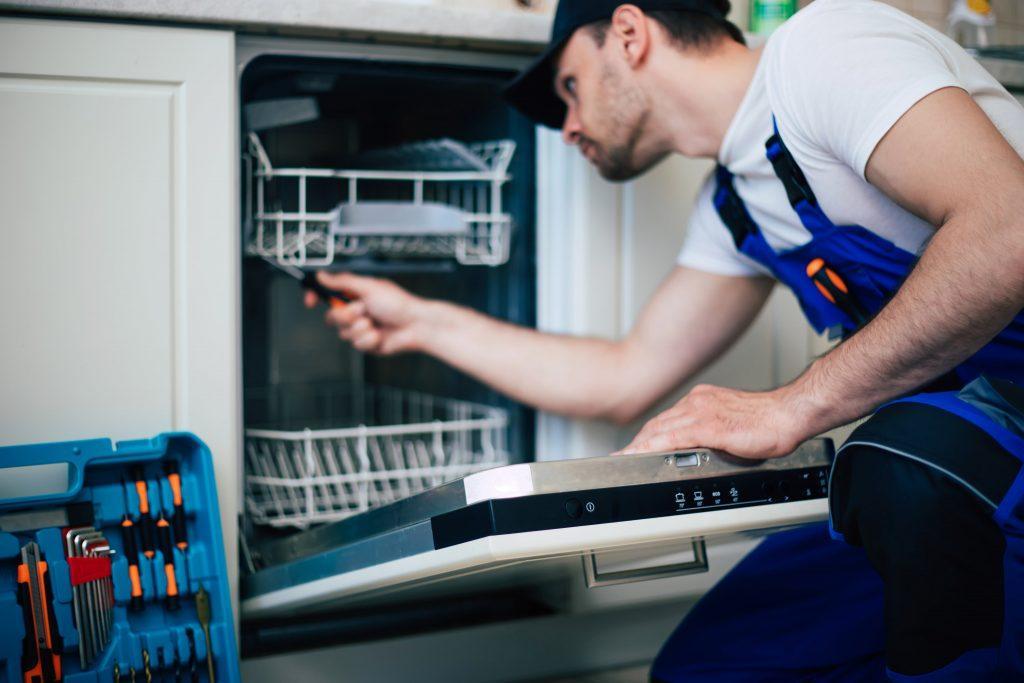Why is My Dishwasher Leaking?
As a homeowner, you want to make sure that your dishwasher is functioning properly.
If it starts leaking, then you might need to take some action in order to prevent water damage and mold growth.
A dishwasher leak can be caused by issues with the water supply, blockage in the dishwasher, fault in a dishwasher part, or improper dishwasher positioning.
Fortunately, there are several solutions to sort the issues.
In this blog post, we’ll discuss reasons your dishwasher might be leaking and how to solve them.

Causes of Dishwasher Leaks
1. Inadequate Water
The most common reason for leaks is because there isn’t enough water in the dishwasher before running it.
This could lead to one of two scenarios: either the dishes won’t get clean or they will flood out onto your kitchen floor when you open the door.
To prevent this, make sure that you add enough water so that it reaches at least 1/2″ below where the bottom rack sits on its support arm.
Alternatively, use a sprayer nozzle so all of the dishes are uniformly wet with hot water.
2. Too Much Detergent or Rinse Aid
Avoid adding too much detergent in one wash.
If you are using a dishwasher liquid, use the recommended amount per load. Do not overfill the dispenser with powder or gel products.
Too much detergent and rinse aid will create suds that start to overflow out of your machine when it is running.

3. Dishwasher Build-up
It could be caused by hard water buildup on the inside and outside of your dishwasher.
This problem can be solved by adding two tablespoons of vinegar to the bottom rack when you are loading up dishes.
Then go ahead and add an extra rinse cycle after completing your load.
4. Water Inlet Valve
It could also be caused by the water inlet valve at the back of the machine not working correctly.
The water inlet valve may also be damaged. You can fix this by replacing the inlet valve.
5. Dishwasher Overflow Issue
There may be an issue with your dishwasher overflow hose.
It may be too short and water flows out of the end when you have a full load going through the wash cycle.
The solution to this problem would be to lengthen or replace the overflow hose.
6. Faulty Inlet Valve
There also may be an issue with the inlet valve. You can fix this by replacing the water inlet valve on the back of your machine.
How Do I Find a Leak in My Dishwasher?
If you have a dishwasher and are having problems with it, the first thing that should be done is to check for leaks.
Check inside the dishwasher’s door or underneath it. The water will seep out of any cracks in the seal.
If there is no leak found at either location, then look for other signs of leaks on your appliance such as puddles around your dishwasher, water stains on the floor, or food particles sticking to your dishes.
If you are looking for a leak in your dishwasher, you might also want to check the following:
Check where the water enters your dishwasher and make sure that there is no water slowly leaking out of it.
If you notice any leaks from this area, tighten up the bolts with a wrench or use silicone sealant.
Check if there are any cracks on the surfaces inside your dishwasher.
Water can easily seep through these cracks and create a leak.
Use silicone sealant to cover up these areas so that they do not cause further damage to your dishwater.
Another way to find out if you have any leaks is by checking the water level of your machine.
If it drops more than an inch over 15 minutes or so, then this means that there’s a leak somewhere inside your dishwasher.
How to Fix a Leak in a Dishwasher
Leaks are never fun to deal with, and they can happen at the worst possible time.
If you do find a leak, then it’s important to fix the problem as soon as possible.
The quicker you can get your dishwasher fixed, the less likely there will be major problems down the road.

Fixing Leaks from Fittings
The first thing you need to do is shut off the electricity that powers your dishwasher, usually located near the bottom of it.
Next, start unplugging hoses from under your sink and removing them from your dishwasher as well as disconnecting the power cord coming out of it.

Now use a wrench or pliers to loosen up two fittings on top of your machine:
One is located next to the dishwasher pipe that goes to the sink. The other is located next to the hose coming out of your hot water heater.
After loosening these fittings, you can remove them from the machine.
Now use a screwdriver or pry bar to unscrew screws holding down any panels on top of your washer. It will be easier for you to access the leak.
Check all hoses for leaks and replace any rubber washers that are worn out or cracked in order to fix a leaking dishwasher.
If you want to avoid this problem altogether, it is recommended that you install an insulated hot water line from your kitchen faucet into your dishwasher’s cold-water inlet.
Fixing Leaks around the Dishwasher Door
Dishwashers are notorious for leaking around their doors if they have not been installed properly or if the seal has been damaged.
To fix a leak at door, check the bottom and back edge for any gaps. Fill in with silicone caulking or contact cement (not on the front of the seal). Allow it to dry before use.
Fixing Leaks under the Sink
To fix a leak under the sink, clean the underside of the seal with a damp cloth and let it dry.
Apply silicone caulking to fill in any gaps between the seal and the countertop edge or backsplash (not on the front of the seal).
When you try out the above fixes and the dishwasher is still leaking, it’s time to call a professional.
Contact an appliance repair company to come out and take a look at what’s going on with your machine.
If the dishwasher is not leaking, but you want it to be quieter then read this article instead!


